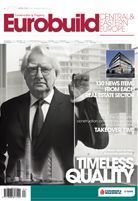One of the most eminent contemporary American architects, Richard Meier has returned to Central Europe for a new office project in Prague. In an exclusive interview with 'Eurobuild CEE', the Pritzker award winner tells us why he is steering away from the hottest real estate markets, what his future dream project is, and what is so special about the colour white
Mladen Petrov, 'Eurobuild CEE': Welcome back. You are not exactly new to the region. Besides two projects in Prague, you were one of the world- famous architects invited to enter designs for the Lilium Tower project in the centre of Warsaw, in a competition that was eventually won by Zaha Hadid but is currently on hold. What is your main impression of Warsaw?Richard Meier : I have very fond memories of Warsaw. I was very happy to visit the city back in 2005. This is where I met two young Polish architects who gave me a very good tour of the city. I also gave a lecture to students while in Warsaw and was amazed by the wond






























































